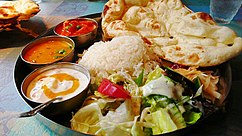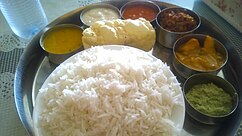Indian vegetarian cuisine
This article needs additional citations for verification. (September 2016) |
India has the largest vegetarian population in the world.[1][2] Vegetarianism in India dates back to ancient times, rooted in various cultural and religious traditions.[3] Even among higher priestly castes, non-vegetarian diets may be observed.[4] Additionally, many Indians who typically consume meat may switch to a vegetarian diet during religious festivals.[5]
A significant number of Indian vegetarians also avoid eggs, in addition to meat.[6] The diversity of vegetarian cuisines across India reflects the country’s rich culinary traditions.[7]
Regional Variations
[edit]Indian vegetarian cuisine is highly diverse, with significant regional variations that reflect the country's vast cultural differences.
North Indian Vegetarian Cuisine
[edit]North Indian vegetarian cuisine often includes dishes made from dairy products like paneer (Indian cottage cheese), and a variety of lentils and beans. Staple dishes include **dal makhani**, **aloo gobi** (potato and cauliflower curry), and **palak paneer** (spinach and paneer curry). Bread, such as **naan**, **roti**, and **paratha**, is a central component of the meal. Spices like cumin, coriander, and garam masala are frequently used to enhance the flavor.[8]
South Indian Vegetarian Cuisine
[edit]In contrast, South Indian vegetarian cuisine emphasizes rice-based dishes, such as **idli**, **dosa**, and **sambar**. Coconut is widely used in cooking, along with tamarind to add a tangy flavor. Popular dishes include **rasam** (a thin soup), **avial** (a vegetable dish made with coconut and yogurt), and **pongal** (a rice and lentil dish). The use of curry leaves, mustard seeds, and dried red chilies is common in South Indian cooking.[9]
Western Indian Vegetarian Cuisine
[edit]Western India, particularly Gujarat, is known for its predominantly vegetarian cuisine, with dishes that often have a sweet, salty, and spicy flavor profile. Some well-known dishes include **dhokla** (a fermented rice and chickpea snack), **undhiyu** (a mixed vegetable dish), and **thepla** (a spiced flatbread). Maharashtra's vegetarian fare includes **pav bhaji** (a spicy vegetable mash served with buttered bread) and **puran poli** (a sweet stuffed flatbread).[10]
Eastern Indian Vegetarian Cuisine
[edit]Eastern India, including Bengal, offers vegetarian cuisine that often incorporates mustard oil and poppy seeds. Popular dishes include **shukto** (a mixed vegetable dish with a bitter element), **aloo posto** (potatoes cooked with poppy seeds), and **begun bhaja** (fried eggplant). Rice is a staple, typically served with lentils and vegetables.[11]
Religious and Cultural Influence
[edit]The prevalence of vegetarianism in India is closely tied to religious beliefs and practices. Hinduism, Jainism, and Buddhism all advocate for a vegetarian diet as part of the principle of ahimsa, or non-violence.[12]
Hinduism
[edit]In Hinduism, vegetarianism is encouraged, especially among certain sects like Vaishnavism and among the Brahmin community. Fasting and religious festivals often involve the temporary adoption of a vegetarian diet, even among non-vegetarians.[13]
Jainism
[edit]Jainism has one of the strictest vegetarian dietary laws, with followers avoiding not only meat but also root vegetables like onions and garlic, which are believed to harbor small organisms that could be harmed during harvesting.[14]
Buddhism
[edit]In Buddhism, especially in the Theravada tradition, vegetarianism is not mandatory but is encouraged as part of a compassionate lifestyle.[15]
Modern Trends and Adaptations
[edit]Indian vegetarian cuisine has evolved over time, influenced by globalization and the increasing demand for healthy, plant-based diets.
Fusion Cuisine
[edit]Fusion dishes that blend Indian vegetarian ingredients with global cuisines have become popular, especially in urban areas. Examples include **paneer tikka pizza**, **curry pasta**, and **Indian-style tacos**.[16]
Veganism in India
[edit]While vegetarianism has a long history in India, veganism is a more recent trend. Many traditional Indian dishes are easily adaptable to a vegan diet by substituting dairy with plant-based alternatives. The growth of veganism has led to the proliferation of vegan restaurants and products across major Indian cities. Veganism is gaining traction not only among health-conscious urban dwellers but also among younger generations who are increasingly concerned about animal rights and environmental sustainability.[17]
Air Catering
[edit]On demand, most airlines offer Indian vegetarian dishes. Some consider these as dietary meals, while others classify them as religious meals, depending on the airline's policy.
Pre-ordering the IATA meal code AVML (Asian Vegetarian Meal) typically provides a meal free of meat, poultry, fish, seafood, and eggs. Common ingredients include vegetables, legumes, fresh and dried fruits, dairy products, tofu, cereals, grains, vegetarian gelatin, and spices typical of the Indian subcontinent. The meal's spice level can range from mild to hot.
Another option is the VJML (Vegetarian Jain Meal), which is more restrictive. Only vegetables that grow above the ground are used, excluding ingredients like onions, garlic, potatoes, carrots, beets, radishes, mushrooms, ginger, and turmeric. Dairy products are also not included.
See also
[edit]References
[edit]- ^ "Which Countries Have the Most Vegetarians?". World Atlas. Retrieved 10 August 2024.
- ^ Edelstein, Sari (2013). Food Science, An Ecological Approach. Jones & Bartlett Publishers. p. 281. ISBN 978-1-4496-0344-1.
...India has more vegetarians than everywhere else in the world combined.
- ^ Simoons, Frederick (1994). Eat not this flesh: food avoidances from prehistory to the present. Univ of Wisconsin Press. p. 6. ISBN 978-0-299-14254-4.
- ^ "Vegetarianism in Hinduism". Alimentarium. Retrieved 2019-11-15.
- ^ "Celebrating Vegetarianism During the Nine Days of Navratri". Down to Earth. Retrieved 10 August 2024.
- ^ Gandhi Smarak Nidhi (1980). Gandhi Marg. Gandhi Peace Foundation.
- ^ Sen, Colleen Taylor (2004). Food Culture in India. Greenwood Publishing Group. ISBN 978-0-313-32487-1.
- ^ "North Indian Cuisine: 10 Best Vegetarian Dishes You Must Try". India.com. Retrieved 10 August 2024.
- ^ "South Indian Cuisine: 10 Dishes You Can't Miss". NDTV Food. Retrieved 10 August 2024.
- ^ "7 Best Dishes from Western Indian Cuisine". Times of India. Retrieved 10 August 2024.
- ^ "East Indian Food - 10 Must Try Dishes". Holidify. Retrieved 10 August 2024.
- ^ "Why Hindus Are Vegetarians: The Link Between Religion and Diet". India.com. Retrieved 10 August 2024.
- ^ "The Importance of Vegetarianism in Hinduism". Learn Religions. Retrieved 10 August 2024.
- ^ "What is Jain Food?". Jain Foodie. Retrieved 10 August 2024.
- ^ "Vegetarianism in Buddhism". BBC Religion. Retrieved 10 August 2024.
- ^ "Delicious Indian Fusion Recipes". The Spruce Eats. Retrieved 10 August 2024.
- ^ "The Rise of Veganism in India". India.com. Retrieved 10 August 2024.


